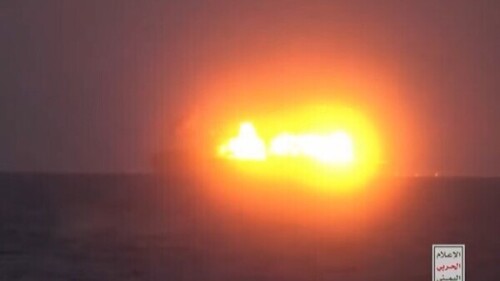Iran has unveiled a new facility capable of rapidly firing ballistic missiles using a unique rail-mounted launcher. |
Iran unveiled a new ballistic-missile facility this week. Key military officials, including Islamic Revolutionary Guard Corps head Hossein Salami, showed off the new site and its apparently unique train-mounted ballistic-missile launcher.
The underground facility appears to showcase Iran’s ability to hide its missiles and then bring them out in the open to fire at enemies.
The new Iranian mobile platforms have wheels and a launcher with a hydraulic leg, Tal Inbar, an expert in missiles and rocketry, pointed out online. The multiple long-range ballistic-missile facility showcases Iran’s abilities and was brought out during the week of US elections, likely as a purposeful jab at the White House.
The “automated and smart system, used for launching multiple long-range ballistic missiles, has been manufactured by the IRGC Aerospace Force,” Iran’s Tasnim News Agency reported.
Video of the new facility was posted online along with media tours. Thus, Iran is not trying to keep this secret. Iran’s message is that this mobile platform could enable numerous missiles to be fired in a “continuous” manner as they are brought out to a launch platform, and then more are brought by the train-style mobile platform. Posters at the facility vowed “severe revenge” against the US. Around five missiles can be wheeled out at a time.
Iranian personnel prepare to move an Emad IRBM from its transport cradle onto the facility’s 5-missile launcher. |
On display was the Emad ballistic missile, which is a liquid-fueled missile that is based on Iran’s successful Shahab line, developed from the Shahab-3. It was successfully tested in 2015 and is also based on a North Korean missile. It has a precision range up to 1,700 km., according to the Missile Defense Advocacy Alliance.
It may be accurate up to 500 meters of its target, which is not as precise as one would want in modern terms of accuracy. But given its size and payload, that is enough to threaten the type of targets Iran would want to strike. These kinds of ballistic missiles are a threat to Israel, the US and allies in the region.
Iran unveiled the missile as it sent Foreign Minister Javad Zarif to Venezuela on an “American tour.” This was also designed to be done during the US election week to show Iran’s foreign-policy inroads close to the US.
Iran is also bragging on its Press TV that pro-Iranian militias want to eject the US from Iraq and that these militias are giving the US time to pack up and go. This is Iran’s message: We can threaten the US in Iraq, we have inroads south of the US border, and we have new missiles that can be hidden and can strike at Israel, the US and Saudi Arabia.
Iran and its allies in the region, from Iraq to Lebanon, are also seeking to reach out to China to supplant the US role. The pro-Iranian Badr Party in Iraq, for instance, has voiced support for more work with China.
Concerns that Iran has renewed work with North Korea on ballistic missiles are tied to Iran bragging about its new launchers and facilities. The ballistic missiles are the cornerstone of Iran’s indigenous military program and new threats.
It also showed off a new drone this week that could carry its own bombs. This first use of a new type of drone is part of Iran’s success in drone warfare. In addition, Iran says it has new kamikaze drones, called Arash, and other new weapons on the way.
Seth Frantzman is a Ginsburg-Milstein Writing Fellow at the Middle East Forum and senior Middle East correspondent at The Jerusalem Post.








